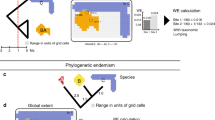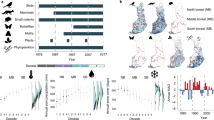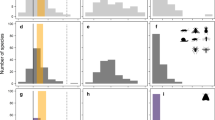Abstract
Despite the broad conceptual and applied relevance of how the number of species or endemics changes with area (the species–area and endemics–area relationships (SAR and EAR)), our understanding of universality and pervasiveness of these patterns across taxa and regions has remained limited. The SAR has traditionally been approximated by a power law1, but recent theories predict a triphasic SAR in logarithmic space, characterized by steeper increases in species richness at both small and large spatial scales2,3,4,5,6. Here we uncover such universally upward accelerating SARs for amphibians, birds and mammals across the world’s major landmasses. Although apparently taxon-specific and continent-specific, all curves collapse into one universal function after the area is rescaled by using the mean range sizes of taxa within continents. In addition, all EARs approximately follow a power law with a slope close to 1, indicating that for most spatial scales there is roughly proportional species extinction with area loss. These patterns can be predicted by a simulation model based on the random placement of contiguous ranges within a domain. The universality of SARs and EARs after rescaling implies that both total and endemic species richness within an area, and also their rate of change with area, can be estimated by using only the knowledge of mean geographic range size in the region and mean species richness at one spatial scale.
This is a preview of subscription content, access via your institution
Access options
Subscribe to this journal
Receive 51 print issues and online access
$199.00 per year
only $3.90 per issue
Buy this article
- Purchase on Springer Link
- Instant access to full article PDF
Prices may be subject to local taxes which are calculated during checkout



Similar content being viewed by others
References
Rosenzweig, M. L. Species Diversity in Space and Time (Cambridge Univ. Press, 1995)
Allen, A. P. & White, E. P. Effects of range size on species–area relationships. Evol. Ecol. Res. 5, 493–499 (2003)
McGill, B. & Collins, C. A unified theory for macroecology based on spatial patterns of abundance. Evol. Ecol. Res. 5, 469–492 (2003)
Hubbell, S. P. The Unified Theory of Biodiversity and Biogeography (Princeton Univ. Press, 2001)
Rosindell, J. & Cornell, S. J. Species–area relationships from a spatially explicit neutral model in an infinite landscape. Ecol. Lett. 10, 586–595 (2007)
O’Dwyer, J. P. & Green, J. L. Field theory for biogeography: a spatially explicit model for predicting patterns of biodiversity. Ecol. Lett. 13, 87–95 (2010)
Lawton, J. H., May, R., eds. Extinction Rates (Oxford Univ. Press, 1995)
Pimm, S. L. & Raven, P. Biodiversity: extinction by numbers. Nature 403, 843–845 (2000)
He, F. & Hubbell, S. P. Species–area relationships always overestimate extinction rates from habitat loss. Nature 473, 368–371 (2011)
Smith, A. B. Caution with curves: caveats for using the species–area relationship in conservation. Biol. Conserv. 143, 555–564 (2010)
Drakare, S., Lennon, J. J. & Hillebrand, H. The imprint of the geographical, evolutionary and ecological context on species–area relationships. Ecol. Lett. 9, 215–227 (2006)
Connor, E. F. & McCoy, E. D. The statistics and biology of the species–area relationship. Am. Nat. 113, 791–833 (1979)
Harte, J., Smith, A. B. & Storch, D. Biodiversity scales from plots to biomes with a universal species–area curve. Ecol. Lett. 12, 789–797 (2009)
Šizling, A. L., Kunin, W. E., Šizlingová, E., Reif, J. & Storch, D. Between geometry and biology: the problem of universality of the species–area relationship. Am. Nat. 178, 602–611 (2011)
Kinzig, A. P. & Harte, J. Implications of endemics–area relationships for estimates of species extinctions. Ecology 81, 3305–3311 (2000)
Pereira, H. M., Borda-de-Água, L. & Martins, I. S. Geometry and scale in species–area relationships. Nature 482, E3–E4 (2012)
Green, J. L. & Ostling, A. Endemics–area relationships: the influence of species dominance and spatial aggregation. Ecology 84, 3090–3097 (2003)
Belmaker, J. & Jetz, W. Cross-scale variation in species richness–environment associations. Glob. Ecol. Biogeogr. 20, 464–474 (2011)
Hurlbert, A. H. & Jetz, W. Species richness, hotspots, and the scale dependence of range maps in ecology and conservation. Proc. Natl Acad. Sci. USA 104, 13384–13389 (2007)
Storch, D. et al. Energy, range dynamics and global species richness patterns: reconciling mid-domain effects and environmental determinants of avian diversity. Ecol. Lett. 9, 1308–1320 (2006)
Buckley, L. B. & Jetz, W. Environmental and historical constraints on global patterns of amphibian richness. Proc. R. Soc. Lond. B 274, 1167–1173 (2007)
Storch, D. et al. The quest for a null model for macroecological patterns: geometry of species distributions at multiple spatial scales. Ecol. Lett. 11, 771–784 (2008)
Losos, J. B. & Schluter, D. Analysis of an evolutionary species–area relationship. Nature 408, 847–850 (2000)
Ricklefs, R. E. A comprehensive framework for global patterns in biodiversity. Ecol. Lett. 7, 1–15 (2004)
McGill, B. J. Towards a unification of unified theories of biodiversity. Ecol. Lett. 13, 627–642 (2010)
Harte, J. & Kinzig, A. P. On the implications of species–area relationships for endemism, spatial turnover, and food web patterns. Oikos 80, 417–427 (1997)
Arita, H. T. & Rodríguez, P. Geographic range, turnover rate and the scaling of species diversity. Ecography 25, 541–550 (2002)
Scheiner, S. M. Six types of species–area curves. Glob. Ecol. Biogeogr. 12, 441–447 (2003)
Leitner, W. A. & Rosenzweig, M. L. Nested species–area curves and stochastic sampling: a new theory. Oikos 79, 503–512 (1997)
Colwell, R. K. & Lees, D. C. The mid-domain effect: geometric constraints on the geography of species richness. Trends Ecol. Evol. 15, 70–76 (2000)
Lennon, J. J., Koleff, P., Greenwood, J. J. D. & Gaston, K. J. The geographical structure of British bird distributions: diversity, spatial turnover and scale. J. Anim. Ecol. 70, 966–979 (2001)
Nekola, J. C. & White, P. S. The distance decay of similarity in biogeography and ecology. J. Biogeogr. 26, 867–878 (1999)
Kunin, W. E. Sample shape, spatial scale and species counts: implications for reserve design. Biol. Conserv. 82, 369–377 (1997)
Šizling, A. L. & Storch, D. Power-law species–area relationships and self-similar species distributions within finite areas. Ecol. Lett. 7, 60–68 (2004)
Acknowledgements
We thank J. Belmaker, K. Mertes-Schwartz, C. Sheard and D. Rosauer for useful comments. The study was supported by the Grant Agency of the Czech Republic (P505/11/2387), the Czech Ministry of Education (MSM0021620845) and the EU FP7 SCALES project (‘Securing the Conservation of biodiversity across Administrative Levels and spatial, temporal and Ecological Scales’; project No. 26852). W.J. acknowledges support from National Science Foundation grants DBI 0960550 and DEB 1026764, and NASA Biodiversity Program grant number NNX11AP72G.
Author information
Authors and Affiliations
Contributions
D.S. initiated the research. D.S., P.K. and W.J. developed the ideas, methods and concepts, and wrote the manuscript. W.J. adjusted and provided the data. P.K. performed the analyses and simulations.
Corresponding author
Ethics declarations
Competing interests
The authors declare no competing financial interests.
Supplementary information
Supplementary Information
This file contains a Supplementary Discussion, Supplementary Tables 1-2 and Supplementary Figures 1-15. (PDF 1864 kb)
Rights and permissions
About this article
Cite this article
Storch, D., Keil, P. & Jetz, W. Universal species–area and endemics–area relationships at continental scales. Nature 488, 78–81 (2012). https://doi.org/10.1038/nature11226
Received:
Accepted:
Published:
Issue Date:
DOI: https://doi.org/10.1038/nature11226
This article is cited by
-
A critical assessment of the biodiversity–productivity relationship in forests and implications for conservation
Oecologia (2023)
-
The Relative Importance of Environmental Filtering and Dispersal Limitation on the Multidimensional Beta Diversity of Desert Plant Communities Depends on Sampling Scales
Journal of Soil Science and Plant Nutrition (2023)
-
Examining the generality of the biphasic transition from niche-structured to immigration-structured communities
Theoretical Ecology (2022)
-
Area modulates the effect of elevation but not of land use or canopy on tropical plant species richness
Biodiversity and Conservation (2021)
-
Why European biodiversity reporting is not reliable
Ambio (2021)
Comments
By submitting a comment you agree to abide by our Terms and Community Guidelines. If you find something abusive or that does not comply with our terms or guidelines please flag it as inappropriate.



